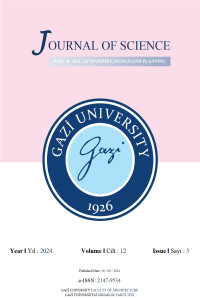Abstract
References
- [1] Feilden, B. (2007). Conservation of Historic Buildings. London: Routledge
- [2] Jokilehto, J. (2017). A History of Architectural Conservation. London: Routledge.
- [3] D'Ayala, D. F., & Forsyth, M. (2007). What is conservation engineering?. Structures & Construction in Historic Building Conservation, 1-11. doi: 10.1002/9780470691816.ch1
- [4] Roca, P. (2011). Restoration of historic buildings: Conservation principles and structural assessment. International Journal of Materials and Structural Integrity, 5(2-3), 151-167. doi:10.1504/IJMSI.2011.041932
- [5] Feilden, B. M., & Jokilehto, J. (1993). Management Guidelines for World Cultural Heritage Sites. Roma: ICCROM.
- [6] Kalčić, H. (2014). Eugène emmanuel viollet-le-duc and monument protection: A case study. Urbani izziv, 25(2), 130-142. doi:urbani-izziv-en-2014-25-02-005
- [7] Ashurst, J., & Ashurst, N. (1988). Brick, Terracotta and Earth. Great Britain: Gower Technical Press
- [8] Jokilehto, J. (1999). A century of heritage conservation. Journal of Architectural Conservation, 5(3), 14-33. doi:10.1080/13556207.1999.10785249
- [9] ICOMOS, U. (1964). The Venice Charter. London: ICOMOS.
- [10] Teutonico, J. M., & Matero, F. G. (Eds.). (2003). Managing Change: Sustainable Approaches to the Conservation of the Built Environment. 4th Annual US/ICOMOS International Symposium Organized by US/ICOMOS, Program in Historic Preservation of the University of Pennsylvania, and the Getty Conservation Institute 6-8 April 2001, Philadelphia, Pennsylvania (Vol. 4). Getty Publications.
Conservation and Restoration of Historic Buildings: Application of Contemporary Addition Construction Techniques in the Case of Turkey
Abstract
Historical buildings are important heritages reflecting the cultural identity and aesthetic values of societies. The conservation and restoration of these structures requires the integration of modern technologies as well as traditional methods. Today, the restoration process of historical buildings with developing technology gives good results when applied correctly, even if there are sometimes bad examples. The buildings considered within the scope of the study include Süleymaniye Mosque in Istanbul, Edirnekapı Mihrimah Sultan Mosque, Sultan Suyu Fountain in Konya, Sahabiye Madrasah in Kayseri and Payas Sokullu Mehmet Pasha Complex in Hatay. In the Süleymaniye Mosque, digital modelling and analysis was carried out with reverse structural engineering, and in the Mihrimah Sultan Mosque, the durability of wooden structures was increased with carbon fibre reinforced polymers (CFRP). Three-dimensional modelling was carried out with photogrammetry techniques at Sultan Suyu Fountain, and three-dimensional scanning and modelling techniques were used at Sahabiye Madrasah to digitise the structure. In Payas Sokullu Mehmet Pasha Complex, cracks between stone and marble blocks were filled with micro sandblasting technique. These modern techniques preserve the aesthetic and historical values of the buildings, increase their structural durability and extend their service life. The use of modern additional construction methods in the conservation of historical buildings ensures that these buildings are carried to the future in a safe and aesthetically satisfying way. The safe transfer of these structures to the future will shed light on the next generations to obtain more detailed information about the present and the past.
Keywords
Conservation of Historic Buildings Restoration Contemporary Additional Construction Techniques Cultural Heritage
References
- [1] Feilden, B. (2007). Conservation of Historic Buildings. London: Routledge
- [2] Jokilehto, J. (2017). A History of Architectural Conservation. London: Routledge.
- [3] D'Ayala, D. F., & Forsyth, M. (2007). What is conservation engineering?. Structures & Construction in Historic Building Conservation, 1-11. doi: 10.1002/9780470691816.ch1
- [4] Roca, P. (2011). Restoration of historic buildings: Conservation principles and structural assessment. International Journal of Materials and Structural Integrity, 5(2-3), 151-167. doi:10.1504/IJMSI.2011.041932
- [5] Feilden, B. M., & Jokilehto, J. (1993). Management Guidelines for World Cultural Heritage Sites. Roma: ICCROM.
- [6] Kalčić, H. (2014). Eugène emmanuel viollet-le-duc and monument protection: A case study. Urbani izziv, 25(2), 130-142. doi:urbani-izziv-en-2014-25-02-005
- [7] Ashurst, J., & Ashurst, N. (1988). Brick, Terracotta and Earth. Great Britain: Gower Technical Press
- [8] Jokilehto, J. (1999). A century of heritage conservation. Journal of Architectural Conservation, 5(3), 14-33. doi:10.1080/13556207.1999.10785249
- [9] ICOMOS, U. (1964). The Venice Charter. London: ICOMOS.
- [10] Teutonico, J. M., & Matero, F. G. (Eds.). (2003). Managing Change: Sustainable Approaches to the Conservation of the Built Environment. 4th Annual US/ICOMOS International Symposium Organized by US/ICOMOS, Program in Historic Preservation of the University of Pennsylvania, and the Getty Conservation Institute 6-8 April 2001, Philadelphia, Pennsylvania (Vol. 4). Getty Publications.
Details
| Primary Language | English |
|---|---|
| Subjects | Architectural Heritage and Conservation |
| Journal Section | Architecture |
| Authors | |
| Publication Date | September 30, 2024 |
| Submission Date | July 3, 2024 |
| Acceptance Date | September 15, 2024 |
| Published in Issue | Year 2024 Volume: 12 Issue: 3 |


